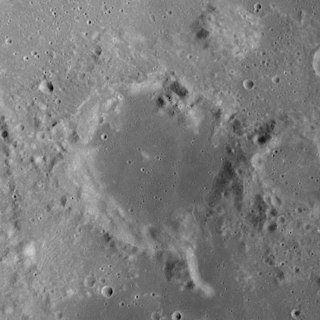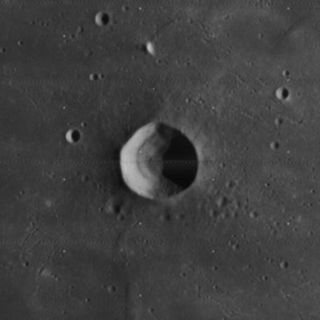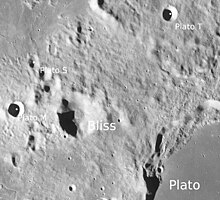
Albategnius is an ancient lunar impact crater located in the central highlands. It is named after the Muslim astronomer and scientist Muhammad ibn Jābir al-Harrānī al-Battānī, Latinized as Albategnius.

Aryabhata, named after Indian astronomer Aryabhata, is the remnant of a lunar impact crater located in the eastern Mare Tranquillitatis. The crater has been almost submerged by lava-flow, and now only an arc-shaped ridge formed from the eastern half of the rim remains above the lunar mare. This crater was previously identified as Maskelyne E before being named by the IAU in 1979. Maskelyne itself is to the southwest.

Carlini is a small lunar impact crater located in the Mare Imbrium. It was named after Italian astronomer Francesco Carlini. The crater is bowl-shaped with a small central floor. It has a higher albedo than the surrounding mare, making it prominent due to its isolated location. To the south is a wrinkle ridge named Dorsum Zirkel, and farther south lies the peak Mons La Hire.
Abetti is a lunar impact crater that has been completely submerged by mare lavas. It forms a 'ghost crater' in the surface, showing only a curved rise where the rim is located. Abetti is located near the southeast edge of Mare Serenitatis, to the west of the Mons Argaeus. This crater is generally visible only at low angles of illumination. It is named after two Italian astronomers, Antonio Abetti and his son Giorgio.

Ching-Te is a small lunar impact crater located in a mountainous area to the east of the Mare Serenitatis. It is a circular, bowl-shaped formation with no distinguishing features.

Plato is a lava-filled lunar impact crater on the Moon. Its diameter is 101 km. It was named after ancient Greek philosopher Plato. It is located on the northeastern shore of the Mare Imbrium, at the western extremity of the Montes Alpes mountain range. In the mare to the south are several rises collectively named the Montes Teneriffe. To the north lies the wide stretch of the Mare Frigoris. East of the crater, among the Montes Alpes, are several rilles collectively named the Rimae Plato.

Euler is a lunar impact crater located in the southern half of the Mare Imbrium, and is named after the Swiss mathematician, physician and astronomer Leonhard Euler. The most notable nearby feature is Mons Vinogradov to the west-southwest. There is a cluster of low ridges to the southwest, and this formation includes the small crater Natasha and the tiny Jehan. About 200 kilometers to the east-northeast is the comparably sized crater Lambert.

Bohnenberger is a lunar impact crater that lies near the east edge of the Mare Nectaris, in the foothills of the Montes Pyrenaeus mountain range that forms the perimeter of the mare. To the east beyond the mountains is the larger crater Colombo. The crater has a low rim along the north wall, and the floor is somewhat irregular with a ridge crossing the floor. There is a small crater along the western inner wall.

Delisle is a small lunar impact crater in the western part of the Mare Imbrium. It was named after French astronomer Joseph-Nicolas Delisle. It lies to the north of the crater Diophantus, and just to the northwest of the ridge designated Mons Delisle. Between Delisle and Diophantus is a sinuous rille named Rima Diophantus, with a diameter of 150 km. To the northeast is another rille designated Rima Delisle, named after this crater.

Maraldi is a worn, eroded crater on the western edge of the Sinus Amoris, in the northeast part of the Moon. To the west-southwest is the crater Vitruvius, and to the northwest lies the worn Littrow crater. Just to the northeast of the crater is the dome-like Mons Maraldi rise.

Conon is a small but prominent lunar impact crater that lies in the eastern foothills of the Montes Apenninus mountain range. The crater is named for the Greek astronomer Conon of Samos. Just to the west of Conon is the long mountainous ridge Mons Bradley. The nearest craters possessing an eponym are Galen, about 70 kilometres (43 mi) to the east, and Aratus, about the same distance to the northeast.

Eckert is a tiny, isolated lunar impact crater in the northern part of the Mare Crisium. This crater forms a circular pit in the dark surface of the surrounding lunar mare. Just to the west is a wrinkle ridge in the mare surface, a feature that is prominent only under oblique lighting from the Sun. The nearest craters of note are Peirce to the west-northwest, and Picard to the southwest. Both of these craters lie in the Mare Crisium basin.

Kirch is a small lunar impact crater in the eastern part of the Mare Imbrium, a large lunar mare in the northwest quadrant of the Moon. It was named after German astronomer Gottfried Kirch. This is a relatively solitary formation with the nearest comparable crater being Piazzi Smyth to the northeast. Notable features in the vicinity are the Montes Spitzbergen mountains to the south and the solitary peak Mons Piton to the east-northeast. Kirch is circular and bowl-shaped, with a dark interior having the same albedo as the surrounding terrain.

Piazzi Smyth is a small lunar impact crater in the eastern part of the Mare Imbrium. It was named after Scottish astronomer Charles Piazzi Smyth. This is an isolated feature located about 100 kilometers to the southwest of the Montes Alpes mountain range. To the southeast of this crater is Mons Piton, an isolated mountain that rises to a height of 2.3 km and occupies a diameter of about 25 km.

Mons Hadley is a massif in the northern portion of the Montes Apenninus, a range in the northern hemisphere of the Moon. It has a height of 4.2 km (14,000 ft) above the adjacent plain and a maximum diameter of 25 km at the base.

Mons La Hire is a solitary lunar mountain in the western Mare Imbrium. It is located to the northeast of the crater Euler, and to the west-northwest of Lambert.

Mons Bradley is a lunar mountain massif in the Montes Apenninus range, along the eastern edge of the Mare Imbrium. It is located to the west of the crater Conon. To the west of this peak is the Rima Bradley rille.

Cassini is a lunar impact crater that is located in the Palus Nebularum, at the eastern end of Mare Imbrium. The crater was named after astronomers Giovanni Cassini and Jacques Cassini. To the northeast is the Promontorium Agassiz, the southern tip of the Montes Alpes mountain range. South by south-east of Cassini is the crater Theaetetus. To the northwest is the lone peak Mons Piton.

Aepinus is a small lunar impact crater located along the northern lunar limb, close to the north pole of the Moon. To the south east is the prominent crater Hermite.

Braude is a lunar impact crater located on the far side of the Moon. The crater is named after radio astronomer Semion Braude. The crater was adopted by the IAU in 2009. The nearest major feature is the Schrödinger crater. Also located nearby is the Wiechert crater, which is located less than 170 kilometers from the southern pole.



















